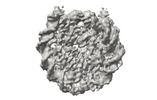+Search query
-Structure paper
| Title | Poly(ADP-ribosyl)ation enhances nucleosome dynamics and organizes DNA damage repair components within biomolecular condensates. |
|---|---|
| Journal, issue, pages | Mol Cell, Vol. 84, Issue 3, Page 429-446.e17, Year 2024 |
| Publish date | Feb 1, 2024 |
 Authors Authors | Michael L Nosella / Tae Hun Kim / Shuya Kate Huang / Robert W Harkness / Monica Goncalves / Alisia Pan / Maria Tereshchenko / Siavash Vahidi / John L Rubinstein / Hyun O Lee / Julie D Forman-Kay / Lewis E Kay /  |
| PubMed Abstract | Nucleosomes, the basic structural units of chromatin, hinder recruitment and activity of various DNA repair proteins, necessitating modifications that enhance DNA accessibility. Poly(ADP-ribosyl) ...Nucleosomes, the basic structural units of chromatin, hinder recruitment and activity of various DNA repair proteins, necessitating modifications that enhance DNA accessibility. Poly(ADP-ribosyl)ation (PARylation) of proteins near damage sites is an essential initiation step in several DNA-repair pathways; however, its effects on nucleosome structural dynamics and organization are unclear. Using NMR, cryoelectron microscopy (cryo-EM), and biochemical assays, we show that PARylation enhances motions of the histone H3 tail and DNA, leaving the configuration of the core intact while also stimulating nuclease digestion and ligation of nicked nucleosomal DNA by LIG3. PARylation disrupted interactions between nucleosomes, preventing self-association. Addition of LIG3 and XRCC1 to PARylated nucleosomes generated condensates that selectively partition DNA repair-associated proteins in a PAR- and phosphorylation-dependent manner in vitro. Our results establish that PARylation influences nucleosomes across different length scales, extending from the atom-level motions of histone tails to the mesoscale formation of condensates with selective compositions. |
 External links External links |  Mol Cell / Mol Cell /  PubMed:38215753 PubMed:38215753 |
| Methods | EM (single particle) |
| Resolution | 3.3 - 3.7 Å |
| Structure data |  EMDB-41178: Cryo-EM map of the PARylated nucleosome core particle in 5 mM KCl with local resolution values  EMDB-41182: Cryo-EM map of the Unmodified nucleosome core particle in 100 mM KCl with local resolution values  EMDB-41183: Cryo-EM map of the PARylated nucleosome core particle in 100 mM KCl with local resolution values  EMDB-41184: Cryo-EM map of the Unmodified nucleosome core particle in 5 mM KCl with local resolution values |
| Source |
|
 Movie
Movie Controller
Controller Structure viewers
Structure viewers About Yorodumi Papers
About Yorodumi Papers




